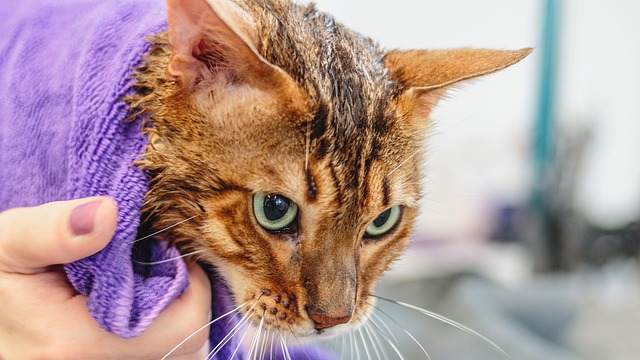
Cats don’t normally need to be bathed, as they wash and groom themselves several times a day. However, there will be a time when you need to bathe your cat. It may be before a show, an outdoor cat may be extremely dirty and need help getting the mud off, or you may have a flea infestation that needs to be taken care of. Even indoor cats can get dirty, especially if you are painting or redecorating.
I urge you to get your new kitten used to be bathed every week. This will make her life much easier when she becomes an adult cat. However, you can still bathe an adult cat that is not used to it. You’ll just need more patience and help.
If it’s necessary to bathe your cat, you must be prepared. Choose the room in which you will bathe your cat. I suggest the laundry room or the kitchen sink. Both rooms should have tubs deep enough to safely bathe your cat while still being at a good height for your back.
Have the following items ready before you begin.
- A rubber mat to place in the sink so your cat doesn’t slip.
- Two bowls of hot water for rinsing.
- Keep them close by.
- A towel to place your cat on when you’re done bathing, and another one or two to dry him off.
- A special cat shampoo. Never use human shampoo, as it’s too harsh on your cat’s skin. Even baby shampoos contain additives you don’t want around your cat.
- A face wash or a small, soft washcloth.
- A few treats to encourage her during and after the bath.
- Someone to help you.
You need to get your cat used to the idea of being in the sink. Then, just use a few handfuls of water on his coat and massage him. During these training sessions, do not use shampoo, just get your cat used to being in the sink and smelling the water. Speak softly and encourage your cat at all times. If it wants to get out, don’t force it. You’ll have to keep trying until it feels safe there. By giving treats at each stage, you’ll hope your cat is happy to stay in the sink.
When you and your cat are ready for the big day, make sure everything is in place and within reach. This time, wet the entire surface of the cat, except for the head. Never pour water directly from the faucet onto your cat, and don’t put the plug in the sink because you don’t want the cat to be in the water.
Pour the water on your cat slowly or use a wet washcloth. Then rub the shampoo in as if you were massaging your cat. Once the entire coat has been shampooed, you can rinse it off by pouring small amounts from the bowl.
Once the shampoo is completely rinsed off, place your cat on the towel and use the other towels to rub it vigorously to dry it. Be wary of using a hair dryer, as the noise and hot air may scare your cat.
If your cat is a long-haired breed, you may also consider using a cat conditioner.
The other person should always stand at the cat’s head, hold it gently, talk to it and give it treats. I wouldn’t worry too much about the calories in the treats while bathing, you want your cat to be happy.
If your cat is too upset about the bath, don’t push it. Let the vet or a qualified professional groomer take over. You don’t want to risk being scratched or bitten, nor do you want to destroy your cat’s trust in you.
If you try to limit your cat’s bathing process to five minutes or less, you’re doing well. If you exceed that time, the cat will object.
Remember, bathing your cat should not be a chore. It should be an activity you both enjoy. And if you’re thinking of adopting a kitten, start training and bathing her early.






